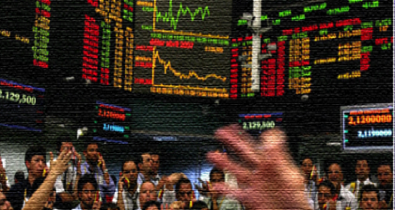TUESDAY JUNE 13, 2000
STOCK MARKET MICROSIMULATION

The goal is to have, on the one hand, the simplest and most parsimonious description of the market and, on the other hand, the most faithful representation of the observed market characteristics (Stigler, 1964).
FINSIM: An agent -- based model of stock market fluctuations
FINSIM is a (computational) model to simulate the dynamic interactions between market price and the decisions of different kind of traders. They possess spatial mobility and group together to form coalitions. Each coalition follows a strategy chosen from a proportional voting “dominated” by a leader's decision. The interplay of the different kind of agents gives rise to complex price dynamics that is consistent with the main stylized facts of financial time series.
In the alpha version of the model there were two kinds of agents trading for a single asset (stock):
fundamentalists and noisy. The former consider a reference (or “fundamental”) value to determine the ``right'' price of an asset. The latter represent most of the “small” traders which do not follow any reference value and do not look at charts. Their behavior is mostly random.
We later introduced traders which take into account information about the evolution of the price, namely the moving average over certain horizons of time. These are the traders that we name chartists.
To model how the decisions of agents are influenced by their mutual interaction, we assume that the decision process undergoes a proportional voting where agents occupying the same lattice site
express their preference. The single agent's decision is weighted by its influence strength to form the collective decision.
The current price of an asset is determined by a single market maker. Agents trade (buy/sell) assets according to certain rules.
Some agents have more influence than others and represent a brokerage agency where
people go to ask for advice. They group together inside each lattice site to form a collective system
and to follow a common strategy according to proportional voting. Traders are free to diffuse on a two-dimensional lattice to model the tendency to change opinion and to follow a different advisor.
The model is consistent with fat tails of histogram of returns, log-normal distribution and clustering of volatility. The structure of the model is versatile enough to allow future expansion.
FINSIM Ver. 1.0 consists of about 4000 lines of ANSI C code optimized for performance and memory management.
F. Castiglione and D. Stauffer. Multi-scaling in the Cont-Bouchaud microscopic stock market model. Physica A, 300(3-4): 531-538 (2001)
F. Castiglione, RB Pandey and D Stauffer. Effect of Trading Momentum and Price Resistance on Stock Market Dynamics: A Glauber Monte Carlo Simulation. Physica A, 289(1-2): 223-228 (2001)
F. Castiglione. Forecasting price increments using an artificial Neural Network, in Complex Dynamics in Economics, a Special Issue of Advances in Complex Systems, 3(1): 45-56, Hermes-Oxford (2001)
M Bernaschi and F. Castiglione. Effect of technical traders in a synthetic Stock Market. Int J Mod Phys C 11(7): 1437 (2000)
F. Castiglione. Diffusion and Aggregation in an Agent Based Model of Stock Market Fluctuations. Int J Mod Phys C, 11(5): 865-880 (2000)
F. Castiglione. Forecasting price increments using an artificial Neural Network, in Modeling Complexity in Economic and Social Systems, F. Schweitzer (ed.), World Scientific, Singapore 2002, 395 pp. 45-56 (ISBN 981-238-034-5)
SYSTEM